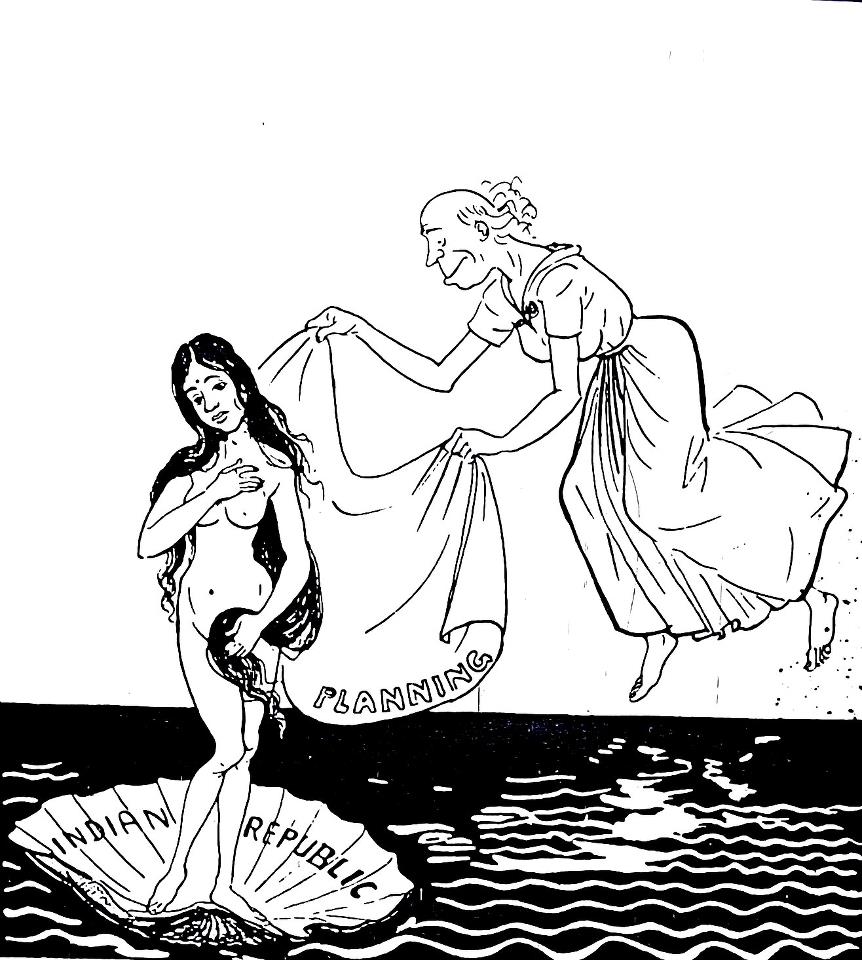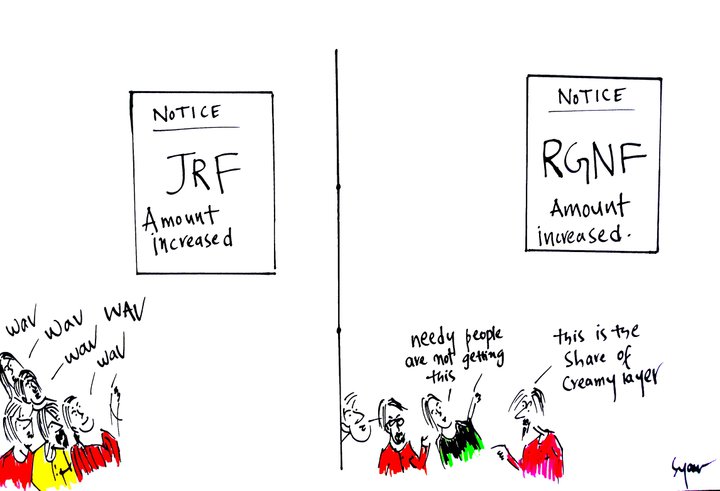Jenny Rowena
On a broken tar road in a rather remote area in Kerala (where I am right now), someone has scribbled this with white chalk:
Sister, For You, Bad New Year
(Sahodari, ninakkuvendi, bad New Year)
This statement is addressed to the girl who passed away recently after being brutally raped in a bus in Delhi. It clearly reproduces the language of the regional newspapers, which is bursting with the news of the Delhi protests and which repeatedly addresses the Delhi girl as the ‘daughter’ and ‘sister’ of the nation. However, in spite of the way it has made its presence felt even in distant places, one cannot help seeing that these protests are very superficial or cosmetic in nature. They do not really engage with the urgent issues concerning a majority of women and might have no real impact on their lives.i ii

That we are able to produce a national debate on rape without involving those who are most affected by it – the Dalit, Adivasi and other minority women – and by focusing on those who have the greatest protection against it, is indeed a moment of failure for all. From this sleepy village in Kerala, which is strangely affected by what is happening in distant Delhi, I feel there is an urgent need to think more about this failure.
For this, we need to explore the power and hegemony of the nationalist paradigm, which is clearly at work in these Delhi protests. It is by situating themselves within it that the Brahminical upper caste groups are able to take on a universal self and mobilize themselves in the name of the nation, so as to reinstate their caste Hindu domination. We need to recognize similar nationalistic trends in other contemporary campaigns like the Anna Hazare movement, the anti-Mandal protests, etc.; think more about how mainstream gender debates work in connivance with them; and explore the historical roots of such contemporary formations in Indian nationalism itself.
The Caste Hindu Nation
What is most striking (from here) is the way the protesting groups (in spite of their varied stands on rape, rape laws, feminism and other political issues) are able to successfully portray themselves as a national collective with the full support of the print and visual media. The raped girl is also portrayed as an archetypal female victim, who cannot be reduced to any caste or community. All tags of identity are denied to her except that of the national. Though she belonged to an OBC (Kurmi) community – a fact that might have influenced her brutal end – this remained hidden till the day she died. Unidentified, she became the ‘daughter’ and ‘sister’ of the nation (and not of any specific community, region or caste). It is no wonder then that this evoked a nationwide response, triggering off similar protests all over the country.
As Madhuri Xalxo recently observed, similar protests against equally brutal violence and injustice “fails to generate a national protest or even a sustained conversation.”iii The resistances in Kashmir and Manipur (that also spoke against the brutal gang rape of women by the army), the large scale protests against the Batla House firing (that involved the killing of students in Delhi), the Dalit women’s recent and powerful struggle against systematic rape by upper caste men in Haryana, (that resulted in the Dalit Mahila Garima Yatra) – none of these resistances and campaigns were able to enter and inhabit the category of the national.iv
To think more about this, let us first examine similar upper caste campaigns.
Recent Upper Caste Formations and their Nationalistic Structure
The Delhi protests are not the first of its kind. In recent times, we have witnessed similar phenomena in the second anti-Mandal protests and the Anna Hazare movement. The public, national mourning against the 26/11 attacks in Bombay and the Pink Chaddi campaign were also closely similar to the above campaigns. Though extremely different in their scope and in the issues that they took up, all of these campaigns brought out an otherwise ‘apolitical’ upper caste community and its youth onto the streets, in the energetic defence of their rights and privileges. All of them evoked national categories, without any reference to particular or specific identities and called upon the entire nation for retribution and justice. All of them were also actively supported by the print and visual media in a most partial manner, which represented them as the voice of the nation, quickly propelling them into national significance. Not surprisingly, all these movements were able to escape the confines of a particular region or location, and spread across the nation.vi
All these campaigns worked by evoking images of a homogeneous national self in danger (female or otherwise), threatened by violent aberrations that were always imagined as situated outside their given (upper caste) locations. In the anti-Mandal protests, the nation was imagined as a space of equality and merit, which was threatened by the divisive demands of the OBC community. In the Anna Hazare movement, corrupt politicians became the dark Asuras (we all know who exactly they are) that threatened the purity of the white-saree-clad Mother India.v The 26/11 mourning was directed at the perennial villain of the nation – the so called fundamentalist Muslim. In the case of the Pink Chaddi campaign and the Delhi protests, the threat was from hooligans (of the Sree Ram Sene) and aberrant rapists prowling the public spaces that the upper caste, urban woman wanted to venture into, with full confidence. vi
It must be remembered that the imagining of such a threatened national self has been at the root of both Hindutva and nationalist politics in this country. However, before we move on to look at the historical roots of such a process, so as to assess its political implications, it would be important to explore how mainstream gender discourses work in connivance with the dominant national.
Gender as a tool of nationalist mobilization
Caste Hindu formations have always used gender and women as a mobilizing tool in this country. Both the Hindu and nationalist mobilizations imagined the nation as a pure (Caste Hindu) woman, who had to be protected and procured from the marauding male hands of the British and the Muslims. Feminist discourses have critiqued such a patriarchal appropriation of women. Yet through their inability to produce a critique of Caste Hinduism and through their singular focus on the Hindu, upper caste woman, they also have ended up reiterating the nationalist woman in all their discourses.
Take a look at the following critique of the feminist movement put forward by Flavia Agnes:
The leaders of this autonomous movement remained predominantly urban and upper class Hindu….. In order to propagate the new ideology of the strong and assertive woman, the movement adopted a populist approach and relied upon mythical symbols of Shakti and Kali to convey the newly constructed feminist ideology….In order to establish its Indianness it relied on Hindu iconography and Sanskrit idioms denoting woman power. viii
Similarly, Indian feminism always worked alongside Caste Hindu forces in the public realm. For instance, in the feminist struggle against dowry death, the fact that they never questioned the caste system gained them the support of upper caste male crowds associated with Hindu groups.
Here is how Radha Kumar talks about this in her rather candid study of the Indian Women’s movement:
Interestingly, feminists were joined by local residents from their first demonstration, and within some months of the campaign groups of residents and professionals also began, independently, to make similar protests. Though this temporarily boosted the morale of the feminists, visions of a snowballing movement were first disturbed by the discovery that many of these other groups came from the right-wing Hindu chauvinist stream of the social reform movement.viii
As many mainstream feminists (Uma Chakraborthy, Susie Tharu and Tejaswini Niranjana) have recognized, we also saw the use and circulation of the feminist discourse in the anti-Mandal protests and in the Hindu call for a Uniform Civil Code following the Shah Bano judgement.
Both in the Pink Chaddi campaign and in the anti-rape protests we see similar trends repeating. Here too we see the construction, promotion and circulation of a homogenous category of woman. Here too the gender debate is always about an unnamed, unlocated patriarchy. Thus it never leads to a critique of the upper caste community and the violence that it installs on ‘other’ women and on upper caste women. More importantly, it always centres on an outside force, the ‘other’ men that the upper caste woman encounters in the public realm and whom she has to be constantly protected from. All of this leaves it open for the hegemonic national, and various upper castes groups with clear casteist politics are able to join in and be part of it. In turn, the gender discourse, which has gained a kind of political legitimacy in India (and the world over) helps invigorate such nationalist formations.
Before thinking more of these formations, it would be important to trace their historical roots to early nationalist discourses.
Historical roots of contemporary upper caste formations
Most mainstream understanding of Indian nationalism think of it as a postcolonial phenomenon, where in a suppressed colony asserted itself against an oppressive empire. In spite of this, they argue, nationalism was often accessible only to the upper castes. So it excluded the lower castes and minorities, who fell outside its ambit and thereby of Indian modernity itself.
However, one sees a different way of thinking about nationalism in the writings and speeches of many dalit and bahujan leaders like Phule, Periyar and Ambedkar; later theorists like G Aloysius, Braj Ranjan Mani;and writers like K KKochu and J Raghu in Kerala. All of them seem to think of nationalism as a strategic organizing principle of the upper castes, which allowed them to successfully consolidate themselves against the onslaught of the anti-caste identities of various lower caste and dalit groups in India. With it, the brahminical upper castes, who had made use of colonialism to consolidate their cultural power, came forward to demand a transfer of power towards their own benefit.
In other words, it was not that the brahminical class had better access to nationalism and modern categories, which resulted in the exclusion of all “others.” Instead the argument that can be built from the available pool of dalitbahujan thinking is this: the brahminical upper caste re-imagined themselves through national categories, put forward a nationalistic politics and countered the lower caste mobilizations that invoked particular caste categories and locations, with a more universal and all pervading nationalist identity. With this they took over the nation and its various dominant categories like secularism, merit, progress and modernity, and gained almost absolute control over its numerous institutions – from academics to administration to art and popular culture.
Given this, the nationalist paradigm is central to upper caste mobilization and politics even today. With this, even today the upper castes launch their political selves, in the name of the nation (with the full support of its intellectuals and media) totally delegitimizing, eclipsing and marginalizing all other contemporary, dalit, lower caste, tribal and minority/muslim, political mobilizations. Be it the anti-Mandal protests, the Pink Chaddi campaign, the 26/11 mourning or the current protests in Delhi, all of these enter and inhabit the ‘national’ for a similar purpose. Just as nationalism once did, today such upper caste mobilizations allow various upper caste groups (ranging from the rabidly hindu to the radical left) to come together (in spite of their many differences) so as to generate a vocabulary of protest and resistance, usurped from contemporary subaltern politics, in order to destroy them, silence them, speak in their names, or do some such act of containment or management.
For instance, the anti-rape discourse of the upper caste Delhi protesters, even as it borrows from the recent Dalit women’s resistances against the systematic gang rapes in Haryana, also works to totally exclude them and attempts to silence this movement with its display of ‘national’ power.
Given all this, it is extremely important that we think more about the nationalist paradigm within which such campaigns and protests are being staged. It is not enough that we condemn them for their exclusionary, upper caste nature. We need to see that we are actually witnessing the consolidation of an upper caste political class, which is using such cosmetic protests to create a nationalist political platform and network.
Orchestrated and aided by nationalist political groups and formations, with the active participation of extremely violent and casteist organizations like BJP, and similar formations like Aam Aadmi party (all of which do not seem to ring any warning bells for the many feminists and other upper caste intellectuals speaking in support of it), supported by radical-left student bodies like AISA and DSU, and various mainstream journalists and intellectuals, this is nothing but one of the important methods the upper castes have always used to imagine themselves through the nationalist paradigm. It is this which will work to establish them as the most valid, visible, political subjects of the Indian nation and allow them to carry on with their dominance over it.
We have to recognize that this is a hundred times more horrifying and violent than the brutal rape that the Delhi protestors are agitating against; and that this is at the root of most social injustices, including that of gender violence, in this nation that is not ours.
~
i) As Anu Ramdas writes in a recent article: “No, we are not going to say why no outrage for the rape and murder of the 8 year old dalit girl in Bihar, and why no outcry for the series of horrifying gang rapes on dalit women by upper caste men in Haryana. Dalit and adivasi girls and women are raped, gang raped, mutilated and murdered all over the country by upper caste men, dominant caste men, men in uniform, and some of them, like women in all communities across castes and classes are raped by their own husbands and other relatives. Rape is not used just as an instrument of violence; it is used to perpetually define both the gender and caste vulnerability of dalit and adivasi women. You see, our battle appears to be different one“.
ii) For a detailed study critique of the large scale feminist mobilizations against the rape of an adivasi woman in police custody, which neither resulted in justice for the woman or made any significant change in the systematic rape that dalit and adivasi women have been encountering for centuries, please see J Indira’s Mphil thesis – J. Indira, “Study of Sexual Violence: A Case of Rape against Dalit Women.” M.Phil. dissertation, University of Hyderabad, 1997.
iii) Delhi Protests and the Caste Hindu Paradigm: Of Sacred and Paraded Bodies. Madhuri Xalxo, SAVARI.
iv) On the contrary, being attached to a particular identity and trying to build a politics out of this, actually guarantees a certain friction with the dominant, national self. This leads to your politics either being branded antinational or you are slotted into a particular niche where you are allowed a controlled display of your particular identity, which never acquires the power and force of the dominant national.
v) Critiques of Janlokpal Bill and Anna Hazare protests on Round Table India
vi) In fact, the dangerous battle cry for death penalty for rapists, which inspires the Delhi protests, is the normal/violent nationalist response to this sense of threat. Behind its articulation is nothing but the need to punish the violent “others” that are threatening the legitimate safety and security of the powerful, uppercaste, national self. Mainstream women’s groups are only worried that such a move will make conviction of rape victims difficult. However, just as in the Anna Hazare campaign – when we were all afraid that Dalits, Adivasis, OBCs and Minorities/Muslims will be the ones who will get punished with the coming of the Lokpal Bill – we are now afraid that it is men from these communities, who will eventually be hanged or chemically castrated.
vii) Women’s Movement within a Secular Framework Redefining the Agenda, Flavia Agnes, Economic and Political Weekly May 7, 1994
vii) The History of Doing; An Illustrated Account of Movements for Women’s Rights and Feminism in India, 1800-1990 by Radha Kumar.
~~~
Cartoon by Shankar, depicting Jawaharlal Nehru as an old woman, without Gandhi cap on his head, draping the ‘Indian Republic’ (or ‘Bharat Mata‘) in a sari. This cartoon was published in the Penguin Book of Indian Cartoons, 1988, by Abu Abraham. It was originally published in Shankar’s Weekly in the 1950s. Shared by Unnamati Syama Sundar.
This article is also published on SAVARI










